ID: 16
Medically significant: yes
Classification agreed: y
Contentious not verified: n
In ncbi taxonomy database: y
Available from atcc: y
CBS: y
Previous CBS: unknown
Sexual CBS: n
Contentious name: n
Previous name, contentious name: unknown
Sexual form exists: y
Sexual form contentious name: n
Sexual form name: Sartorya fumigata
Sexual form author: O'Gorman, Fuller & Dyer doi:10.1038/nature07528
Sexual form in ncbi taxonomy database: n
Previous name in NCBI taxonomy database: unknown
Previous name available at ATCC: n
Reference (original paper):
Fresenius, G. 1863. Beiträge zur Mykologie. 3
Taxonomic family: Fungi, Ascomycota, Pezizomycotina, Eurotiomycetes, Eurotiomycetidae, Eurotiales, Trichocomaceae, Aspergillus
Species images:
-
Micrographs of A. fumigatus conidia & conidial heads provided by Amaliya Stepanova, , Head of Laboratory pathomorphology and cytology at Kashkin Research Institute, Russian Federation.
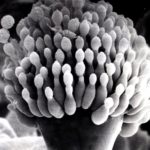 ,
, 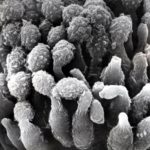 ,
, 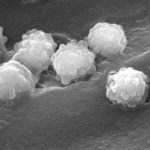 ,
,  ,
, 
-
Scanning electron micrographs of A. fumigatus conidia of the wild-type G10 strain (a). Size bar, 100 nm.
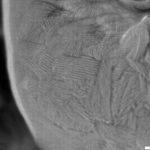
-
Scanning electron micrographs of A. fumigatus conidia of transformants rodB-02 (b). Size bar, 100 nm.

-
These colonies were isolated from a BAL, (also with bacterial qrowth of S.aureus and S.maltophilia) from a patient with a VAP (undergoing corticosteroid treatment). The growth medium used is sabouraud dextrose agar , incubated at 37° C
The identification is made by microscopic/macroscopic observation criteria.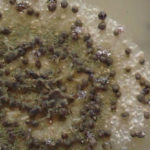
-
A Colonies on MEA after one weekB Detail of colony showing columnar conidial heads x44C, D conidial heads x920E conidia x2330
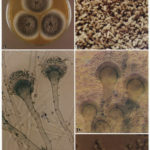
-
Scanning electron micrograph of an A.fumigatus conidium of rodA-47 (c), showing the hydrophobic rodlets covering the surface. Size bar, 100 nm.
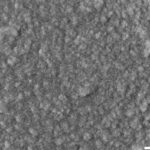
-
Scanning electron micrographs of A. fumigatus conidia of rodA rodB-26 (d).Size bar, 100 nm.
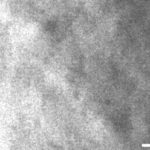
-
microscopic characters Conidiophore stipes(C)225-350um arising from hyphae(Hy):Vesicles(Ves)15-25um wide:Phialides(Ph)uniseriate:Conidia(Con)2.4-3.0um spherical to ovoid,roughened.

-
The growth isolated from the aspergilloma in the presence of living cells of the three bacterial species in culture.The most marked inhibition occurred with Pseudomonas aeruginosa(P) and Haemophilus influenzae(H) and to a much lesser extent with Staphylococcus aureus(S). C=control. Inhibitory factors were components of the bacterial slime layers.
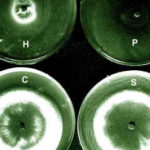
-
Sections of colonised alveoli
On the left, the conidiophores sporulate freely, on the right they are seen to cease development at the phialide stage. Carbon deposits are clearly seen here.A=alveolus, As=alveolar septum, C=conidiophore, P=phialide
-
A four day A. fumigatus culture on malt extract agar (above). Light microscopy pictures are taken at 1000x mag., stained with lacto-phenol cotton blue (right).
![Asp[1]fumigatus Asp[1]fumigatus](https://www.aspergillus.org.uk/wp-content/uploads/2013/11/Asp1fumigatus-150x150.jpg)
-
A four day A. fumigatus culture on malt extract agar (above). Light microscopy pictures are taken at 1000x mag., stained with lacto-phenol cotton blue (right).
![Asp[1]fumighead Asp[1]fumighead](https://www.aspergillus.org.uk/wp-content/uploads/2013/11/Asp1fumighead-150x150.jpg)
-
A four day A. fumigatus culture on malt extract agar (above). Light microscopy pictures are taken at 1000x mag., stained with lacto-phenol cotton blue (right).
![Asp[1]fumighead2 Asp[1]fumighead2](https://www.aspergillus.org.uk/wp-content/uploads/2013/11/Asp1fumighead2-150x150.jpg)
Currently accepted name (anamorph): A. fumigatus
Index Fungorum: Link
Mycobank: Link
Taxonomic family: Fungi, Ascomycota, Pezizomycotina, Eurotiomycetes, Eurotiomycetidae, Eurotiales, Trichocomaceae, Aspergillus
Computed content type (Species): Species
Species
-
Title
Author
Medically significant
Mycobank
Index fungorum
-
Dadalauri, T.G. 1978. Species novae fungorum imperfectorum e terris Georgiae isolatae. Novosti Sistematiki Nizshikh Rastenii. 15:111
unknown
-
Thom, C.; Currie, J.N. 1916. Aspergillus niger group. Journal of Agricultural Research. 7:11
unknown
-
Soares, C.; Rodrigues, P.; Peterson, S.W.; Lima, N.; Venâncio, A. 2012. Three new species of Aspergillus section Flavi isolated from almonds and maize in Portugal. Mycologia. 104(3):694
no
-
Bainier, G.; Sartory, A. 1912. Étude biologique and morphologique de certains Aspergillus. Bulletin de la Société Mycologique de France. 28(3):257
unknown
-
Sartory, A.; Sydow, H. 1913. Étude biologique et morphologique d’un Aspergillus nouveau, Aspergillus sartoryi Syd. n.sp. Annales Mycologici. 11(2):156
unknown
-
Iizuka & M. Yamaz. ex Iizuka & K. Sugiy., J. Jap. Bot. 40: 230 (1965)
unknown
-
Varga, J.; Frisvad, J.C.; Samson, R.A. 2011. Two new aflatoxin producing species, and an overview of Aspergillus section Flavi. Studies in Mycology. 69:63
no

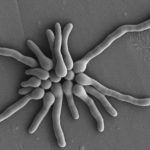
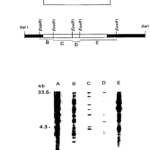
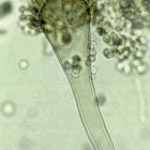

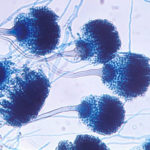
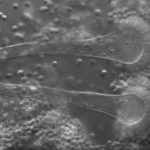
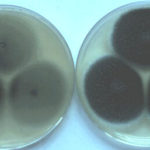
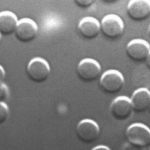
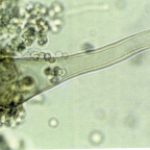

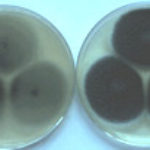
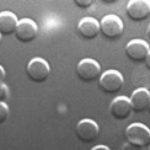
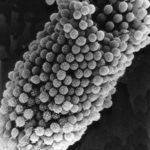
![Asp[1]fumigatus1 Asp[1]fumigatus1](https://www.aspergillus.org.uk/wp-content/uploads/2013/11/Asp1fumigatus1-150x150.jpg)
![Asp[1]fumigheadcopyr Asp[1]fumigheadcopyr](https://www.aspergillus.org.uk/wp-content/uploads/2013/11/Asp1fumigheadcopyr-150x150.jpg)
![Asp[1]fumighead2copyr Asp[1]fumighead2copyr](https://www.aspergillus.org.uk/wp-content/uploads/2013/11/Asp1fumighead2copyr-150x150.jpg)